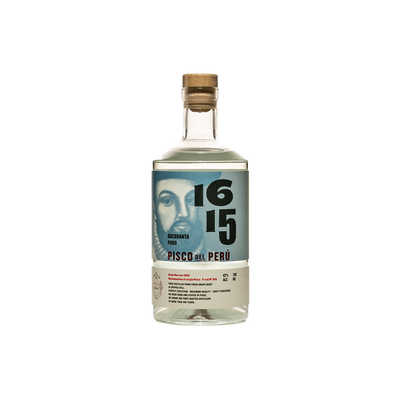Pisco
What is Pisco?
Pisco is a distinctive type of Brandy & Cognac made exclusively from fermented grape juice in South America, specifically Peru and Chile. What sets pisco apart from other grape brandies is its production method—it's distilled to proof without aging in wood, maintaining the pure, clean flavors of the base grapes. This unaged spirit captures the essence of specific grape varieties like Quebranta, Italia, and Moscatel, resulting in a clear, potent spirit that ranges from floral and fruity to rich and earthy depending on the grapes used.
Learn More About Pisco
What makes Pisco unique?
Pisco stands apart from other brandies through its distinctive production method that prohibits aging in wood, resulting in a crystal-clear spirit that showcases the pure, unadulterated flavors of the grapes. While Cognac and Armagnac develop their character through years of oak barrel maturation, Pisco must be distilled to proof and bottled without any additives, aging, or flavor enhancements—creating a remarkably clean expression of terroir. This South American brandy also uses specific grape varieties like Quebranta and Italia that aren't found in European brandy production, giving it flavor profiles ranging from floral and aromatic to robust and earthy that you simply won't find in French or Spanish counterparts.
How is Pisco made?
Pisco starts with fresh grape juice that ferments into wine, which then gets distilled in copper pot stills to concentrate the flavors and alcohol content. The key difference from other brandies is that pisco gets distilled only once and can't be aged in wood, which preserves the pure, clean taste of the original grapes. Depending on the style, distillers either use a single grape variety like Quebranta or blend multiple aromatic grapes such as Italia, Torontel, and Moscatel to create different flavor profiles.
How do you drink Pisco?
Pisco shines brightest in cocktails, where its floral grape character can really show off - think of classics like the Pisco Sour with its frothy egg white crown or the refreshing Pisco Punch that San Francisco made famous. While some South Americans sip it neat or with a splash of ginger ale, most folks find pisco works better as a cocktail base than a straight sipper. You'll find it starring in citrus-forward drinks, often paired with lime juice, simple syrup, and bitters, making it perfect for warm weather gatherings and celebrations where you want something both sophisticated and approachable.
How do I choose a good Pisco?
Start by deciding between Chilean and Peruvian styles—Chilean piscos offer more flexibility with wood aging and additives, while Peruvian piscos showcase pure grape character through stricter production rules. For cocktails like Pisco Sours, grab a solid Peruvian pisco made from Quebranta grapes for clean, bright flavor, but if you're sipping neat or making spirit-forward drinks, consider a premium Chilean pisco or a Peruvian Torontel for more aromatic complexity. Look for producers who list their grape varieties on the label and avoid anything that seems suspiciously cheap—good pisco takes time and quality fruit to make right.
Nutritional Information
Typical Calorie Range per Ounce: 60-70 calories
Typical Carbohydrate Range per Ounce: 0-0.1 grams
Typical Sugar Range per Ounce: 0-0.1 grams
Typically Gluten Free: Yes
Pisco, being a grape-based distilled spirit, naturally contains minimal carbohydrates and sugars since the distillation process removes most of these components. The calories come primarily from the alcohol content itself. As a product made from grapes rather than grains, pisco is typically gluten-free, but always check the specific product label and manufacturer information to confirm gluten-free status, especially if you have celiac disease or severe gluten sensitivity.
Scrolled this far? Your reward? Pisco Trivia!
- Pisco gets its name from the Quechua word "pishqu," meaning bird - specifically referring to the abundant seabirds that once flocked to the coastal valleys where this grape brandy originated. The Spanish colonists noticed these feathered locals and named both the port town and eventually the spirit after them.
- Unlike other brandies that age in wood barrels, authentic Pisco must be stored in chemically neutral containers like stainless steel or glass vessels. This rule exists to preserve the pure, unadulterated flavor of the grapes - meaning every bottle of Pisco tastes exactly like the distiller intended, with zero influence from oak or other woods.
- Pisco producers are forbidden from adding anything - no water, no sugar, no coloring agents, nothing. The spirit that comes off the still at around 38-48% alcohol must go straight into the bottle at that exact proof. This makes Pisco one of the few spirits in the world that's completely unmodified after distillation.
- The earthquake of 1687 in Peru actually helped create modern Pisco production. The massive quake destroyed many wineries, forcing vintners to distill their damaged grapes instead of making wine. What started as a disaster recovery plan became the foundation for Peru's national spirit and a thriving industry.
- Pisco grapes grow in one of the world's most extreme environments - the Atacama Desert region, where some weather stations have never recorded rainfall. The vines survive entirely on underground water sources and morning fog that rolls in from the Pacific Ocean, creating a unique terroir that's impossible to replicate anywhere else on Earth.
Higher-proof spirits can be intense. Mix carefully, taste thoughtfully, and enjoy responsibly.
Gift message (optional)


